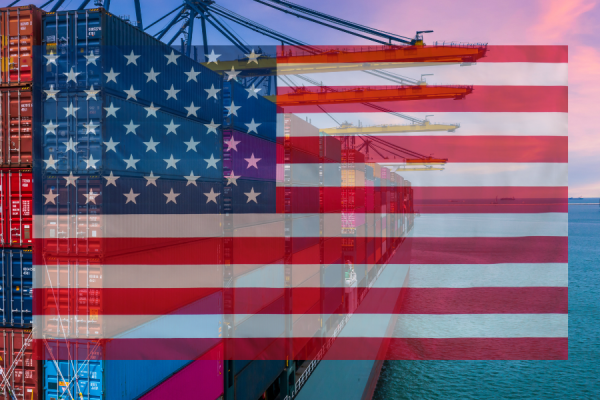
Lauren Wilgus
Published: April 23, 2025
After receiving strong opposition from the global shipping industry to its original February 21, 2025 notice of proposed action levying significant service fees and restrictions on Chinese-built vessels and operators calling to U.S. ports, on April 18, 2025, the United States Trade Representative (“USTR”) announced a revised action plan (“Revised Plan”), which claims to “balance the need for action and the importance of limiting disruption for U.S. exporters.”
Summary
The Revised Plan’s Annexes I-IV define several relevant terms, including “Vessel Operator,” “Vessel owner of China,” “Vessel operator of China,” and “Chinese-built vessel.”
It also sets forth the effective dates and fees to be imposed on these Chinese-built vessels and operators. For the first 180 days the applicable fees will be set at $0. Following this 180-day grace period, the fees will apply in two phases:
In the first phase, after 180 days:
Fees on vessel owners and operators of China based on net tonnage per U.S. voyage, increasing incrementally over the following years;
Fees on operators of Chinese-built ships based on net tonnage or containers, increasing incrementally over the following years; and
To incentivize U.S.-built car carrier vessels, fees on foreign-built car carrier vessels based on their capacity.
The second phase actions will not take place for 3 years:
To incentivize U.S.-built liquified natural gas (“LNG”) vessels, limited restrictions on transporting LNG via foreign vessels. These restrictions will increase incrementally over 22 years.
The Revised Plan
Fees on Maritime Transport Services
Phased fee on Chinese vessel operators and vessel owners
USTR will assess a fee of US $50/NT against any vessel with a Chinese operator or owned by an entity of China calling at U.S. ports, starting October 14, 2025. The new charge will apply to Chinese vessel operators and vessel owners once per vessel rotation at the first U.S. port of entry and will be capped at five assessments per vessel per year. The fee will rise annually for three years reaching up to US $140 by April 2028. To limit potential impacts on smaller ports, the fee will not be imposed at every port of call but only on entry from a foreign destination.
Phased fee on Chinese-built vessels
A fee based on the higher of (i) the net tonnage of the vessel, or (ii) per container will be imposed on Chinese-built vessels not operated by Chinese operators.
The fee will be set at $0 for the first 180 days. Thereafter, the fee will increase as follows:
Effective Date Fee October 14, 2025 a fee in the amount of $18 per net ton for the arriving vessel or a fee in the amount of $120 for each container discharged April 17, 2026 a fee in the amount of $23 per net ton for the arriving vessel or a fee in the amount of $153 for each container discharged April 17, 2027 a fee in the amount of $28 per net ton for the arriving vessel or a fee in the amount of $195 for each container discharged April 17, 2028 a fee in the amount of $33 per net ton for the arriving vessel or a fee in the amount of $250 for each container discharged The fee will be charged up to five times per year per vessel.
In addition, the fees imposed under this Section do not apply to the following.
Chinese-built vessels:
vessels carrying U.S. government cargo;
U.S.-owned or U.S.-flagged vessels enrolled in designated Maritime Administration programs;
Vessels arriving empty or in ballast;
Smaller vessels (below 4,000 TEU, 55,000 DWT, or individual bulk capacity of 80,000 DWT);
Vessels engaged in short sea shipping (voyages shorter than 2000 nm),
Vessels operated by U.S.-owned companies;
Specialised export vessels; and
Vessels principally identified as “Laker Vessels”
Moreover, the Revised Plan exempts ships that carry goods between domestic ports as well as from those ports to Caribbean islands and U.S. territories.
A vessel operator is eligible for a fee remission for up to three years if it orders and takes delivery of a U.S.-built vessel of equivalent size. To meet this requirement, all major components of the hull or superstructure of the vessel must be manufactured in the U.S., including all manufacturing processes from the initial melting stage through the application of coatings for iron or steel products.
Phased fee on vessel operators of foreign vehicle carriers
The Revised Plan assesses fees on foreign-built car carrier vessels based on their Car Equivalent Unit (“CEU”) capacity.
The fee will be set at $0 for the first 180 days. Thereafter, the USTR will impose a fee of US $150 per CEU capacity on non-U.S.-built car carriers entering U.S. ports. Operators can receive a fee remission for up to three years if they order and take delivery of a US-built vessel of equivalent or greater capacity within that period. The remission applies to operators who purchase a U.S.-built vessel of at least equivalent size.
Restrictions on Services to Promote the Transport of U.S. Goods on U.S. Vessels
Restrictions on certain maritime transport
Following a three-year grace period, USTR will impose a restriction requiring the use of U.S. vessels for the maritime transport of a certain percentage of LNG exports.
Beginning on April 16, 2028, the LNG terminal must report to the Department of Energy the amount and percentage of LNG shipped on U.S.-flagged, U.S.-built, and U.S.-operated vessels. From April 17, 2028 to April 16, 2029, 1% of LNG exports must be transported on U.S.-flagged and U.S.-operated vessels.
For every subsequent year, the following percentages of LNG exported by U.S.-built, U.S.-flagged, and U.S.-operated vessels are:
Effective Date Percentage From April 17, 2029, to April 16, 2030 1% From April 17, 2030, to April 16, 2031 1% From April 17, 2031, to April 16, 2032 2% From April 17, 2032, to April 16, 2033 3% From April 17, 2033, to April 16, 2034 3% From April 17, 2034, to April 16, 2035 4% From April 17, 2035, to April 16, 2036 4% From April 17, 2036, to April 16, 2037 6% From April 17, 2037, to April 16, 2038 6% From April 17, 2038, to April 16, 2039 7% From April 17, 2039, to April 16, 204 7% From April 17, 2040, to April 16, 2041 7% From April 17, 2041, to April 16, 2042 9% From April 17, 2042, to April 16, 2043 9% From April 17, 2043, to April 16, 2044 11% From April 17, 2044, to April 16, 2045 11% From April 17, 2045, to April 16, 2046 13% From April 17, 2046, to April 16, 2047 13% From April 17, 2047 15%
The April 9, 2025 Executive Order and Next Steps
On April 9, 2025, President Trump signed an Executive Order titled “Restoring America’s Maritime Dominance (“Executive Order”). The Executive Order establishes several key initiatives with specific deadlines, including a directive to the USTR to consider whether to propose additional duties on certain ship-to-shore cranes and other cargo handling equipment. In response to this direction, the Revised Plan proposes to assess tariffs as follows:
| Item | Proposed Rate |
| Containers (including containers for the transport of fluids) specially designed and equipped for carriage by one or more modes of transport | 20% to 100% |
| Chassis (Trailers and semi-trailers; other vehicles, not mechanically propelled) | 20% to 100% |
| Chassis parts (chassis parts; other parts; castors, other than those of heading 8302) | 20% to 100% |
| Ship-Ship-to-shore gantry cranes, configured as a high or low-profile steel superstructure and designed to unload intermodal containers from vessels with coupling devices for containers, including spreaders or twist-locks | 100% |
The Revised Plan proposes that action with the respect to STS cranes be taken on a non-discriminatory basis.
USTR requests public comments on the proposed tariffs on ship-to-shore cranes, chassis that carry containers and chassis parts, including:
The specific products to be subject to increased duties, including whether the tariff subheadings and product descriptions listed in the Annex V should be retained or removed, or whether tariff subheadings not currently on the list should be added;
The level of the increase, if any, in the rate of duty;
Whether the increased duties should take effect in 180 days, or over a phase-in period of 6 to 24 months.
The Section 301 Committee will convene a public hearing in the main hearing room of the U.S. International Trade Commission, 500 E Street SW, Washington DC 20436, beginning at 10 a.m. on May 19, 2025 regarding the proposed tariff action. The deadline to submit a request to appear at the hearing is May 8, 2025. Public comments on the proposed tariffs are due by May 19, 2025, and post-hearing rebuttal comments seven calendar days after the last day of the public hearing.


